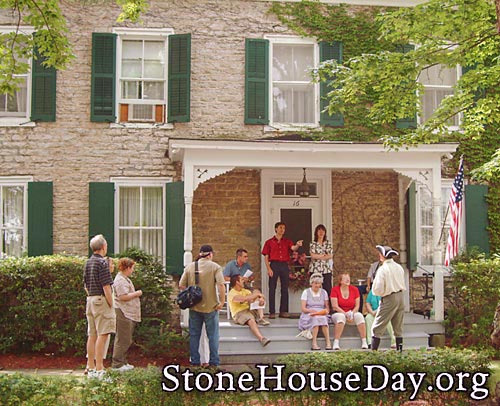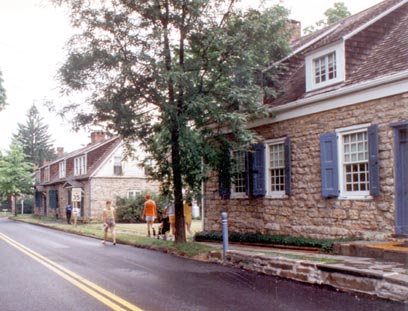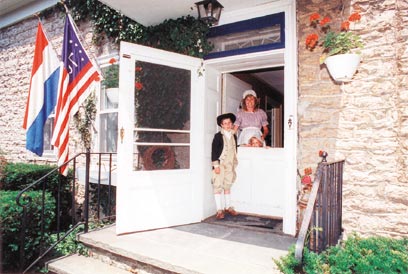|
|
We are sorry to announce that Stone House Day IS NOT BEING HELD until further notice. |
   (Houses close promptly at
Showing several of “America’s Oldest Private Homes”
Stone House Day

“Three hundred years may not be old for private homes in Europe, but in America? In the Mid-Hudson valley? In this town, many hundreds of visitors go through houses that old in six hours, once a year.”
Committee “Old Hurley”—as it is locally known—concentrates twenty-five venerable colonial era residences in a small area—ten of them nestling a few steps from the quarter-mile-long tree-shaded Main Street (where even the “newest” homes are now in their stripling seventies.) The town, a National Historic Landmark just outside of Kingston, was settled by the Dutch in 1661 and in an Indian attack two years later, 34 women and children were taken prisoner. The village was burned to the ground, but the prisoners were rescued unharmed five months later. Most of the 200–300-year-old homes had been built before the Revolutionary War and families in those days feared the village might be burned again. In 1777 British troops had torched all the houses in Kingston, three miles away, and were approaching Hurley when they were unexpectedly called back to their ships on the Hudson River. On that October day a British officer, convicted of spying, was being held prisoner in one of the hamlet’s oldest homes, commandeered as a guard house. The cellar’s walls, over three feet thick, and its dungeon-like rooms—still dank and dismal—made ideal cells for prisoners. After the attack on Kingston, American General George Clinton (later to become vice-president and New York’s governor) ordered the prisoner hanged “when the troops are paraded and before they march tomorrow morning.” But apparently everyone was so busy taking care of refugees from Kingston that another day passed before he met his fate dangling from the bough of a nearby apple tree. The “Spy House,” one of the homes open, features the massive beams common to the era; and some surviving window lights still show the ripples and bubbles of early glass. The door between the large kitchen and the living room is only 5'6" high, so most men and many women have to duck to go through it. The owners are both under five-six, but in spite of their warnings, visitors occasionally “ouch” their way to the next room. That door like the other interior doors still hangs on its original hand-forged hinges, and latches are becoming thinner after three hundred years of use. A hundred yards up the street a 1723 house became the temporary state capitol after the evacuation of Kingston, New York’s first capital until the British burned its buildings. State officials met in Hurley for several weeks until the house became too cold and they moved across the river near Poughkeepsie.
Local lore has it that the Dr. TenEyck house on Main Street served as an Underground Railway stop 150 years ago for slaves escaping from the South and heading for Canada. Across the street is the 1790 Reformed Church parsonage, possibly the oldest church parsonage in the country.
Homes on the tree-shaded Main Street are all within a 150-yard radius
for easy walking and have only a step or two to enter.
Free buses leave every
The Hurley Museum, in a late 1700’s house across from the Van Deusen house,
Those who can spend more than a day in the Mid-Hudson area will find numerous sight-seeing possibilities 10 minutes to an hour away: the Victorian resort at Lake Mohonk, a National Historic Landmark; the Maritime Museum and Hudson River cruises at Rondout; Hyde Park, Franklin D. Roosevelt’s home; the Vanderbilt Mansion and several other estates of wealthy industrialists; Woodstock, the Catskills, and Ashokan Reservoir; West Point; the Senate House in Kingston, the first NYS capitol; Huguenot street in New Paltz; and a grandly-restored Kingston City Hall, the duplicate of an Italian doge’s palace. Kingston also offers its “Historic Trolley-styled bus” ride around the 360-year-old city.
“There’s lots to see and do,” says
To order discount tickets,
go to www.StoneHouseDay.org No reservations are needed. For further information, contact:
The date is always
Although Stone House Day is arranged by the church,
it has become a community project with several organizations and many neighbors volunteering their help.
Since Stone House Day has been attracting visitors from near and far
(there are always a few from foreign countries)
for over
|
 The owners are antique dealers and their home, the VanDeusen House,
features selected colonial furnishings making it a show place of living in early days.
On the other hand, the Spy House displays a number of Victorian-era pieces
passed down from long-ago ancestors.
The owners are antique dealers and their home, the VanDeusen House,
features selected colonial furnishings making it a show place of living in early days.
On the other hand, the Spy House displays a number of Victorian-era pieces
passed down from long-ago ancestors.
 You’ll be greeted by costumed guides in each home who will speak briefly
about the house and its history, but you may spend as much or as little time
in each home as you wish. On part of the street, closed to traffic for the day,
you’ll view life of the 1777 Ulster militia in its authentic encampment,
visit the Library Fair
with its book and collectible sales; and enjoy the Church cafeteria lunch,
handmade crafts, and other, occasionally last-minute, items.
You’ll be greeted by costumed guides in each home who will speak briefly
about the house and its history, but you may spend as much or as little time
in each home as you wish. On part of the street, closed to traffic for the day,
you’ll view life of the 1777 Ulster militia in its authentic encampment,
visit the Library Fair
with its book and collectible sales; and enjoy the Church cafeteria lunch,
handmade crafts, and other, occasionally last-minute, items.